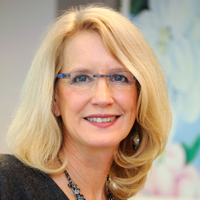Expanding the Pipeline – Engaging Undergraduates in Research: UC San Diego Early Research Scholars Program
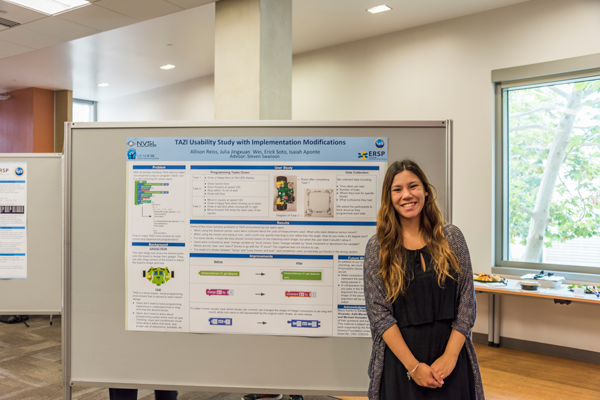
By Christine Alvarado
Engaging undergraduates in research can be an effective way to increase their confidence, perception of science, and sense of belonging [4]. But at many large research universities, it can be difficult for undergraduate students—especially early undergraduates—to find research opportunities. Furthermore, even when they find opportunities, they might not have the background, training, or support to be successful. These issues are particularly acute for women and other underrepresented groups in computer science as they tend to have less pre-college computer science experience [2,3].
At the University of California, San Diego, we created the Computer Science and Engineering (CSE) Early Research Scholars Program (ERSP) to provide early-research opportunities to students, particularly focusing on women and students from racial and cultural groups that are underrepresented in computer science. ERSP provides a structured, supported introduction to research for students who lack the background, confidence, or connections to approach individual faculty to find research projects. Students apply during the spring of their first year at UC San Diego, and they are selected based on their academic performance in their early classes, their motivation to participate in the program, and their understanding of the issues facing students from minority groups in computer science.
They participate in the program during the following academic year. At the start of the year they are grouped into teams of four and matched with a research mentor, who is a faculty member or researcher in CSE (and who is usually assisted by one or more graduate students or post-docs). During the fall, the students take an introduction to CS research course and observe their mentor’s research group meetings. They also work in the fall with their research mentor and the ERSP program director to develop a research proposal. During the winter and spring, they carry out their proposed research as a team under the dual mentorship of the ERSP staff (the program director and a graduate student assistant) and their research mentor. The students present their work in a poster session at the end of the spring quarter. An overview of ERSP’s timeline is shown below.
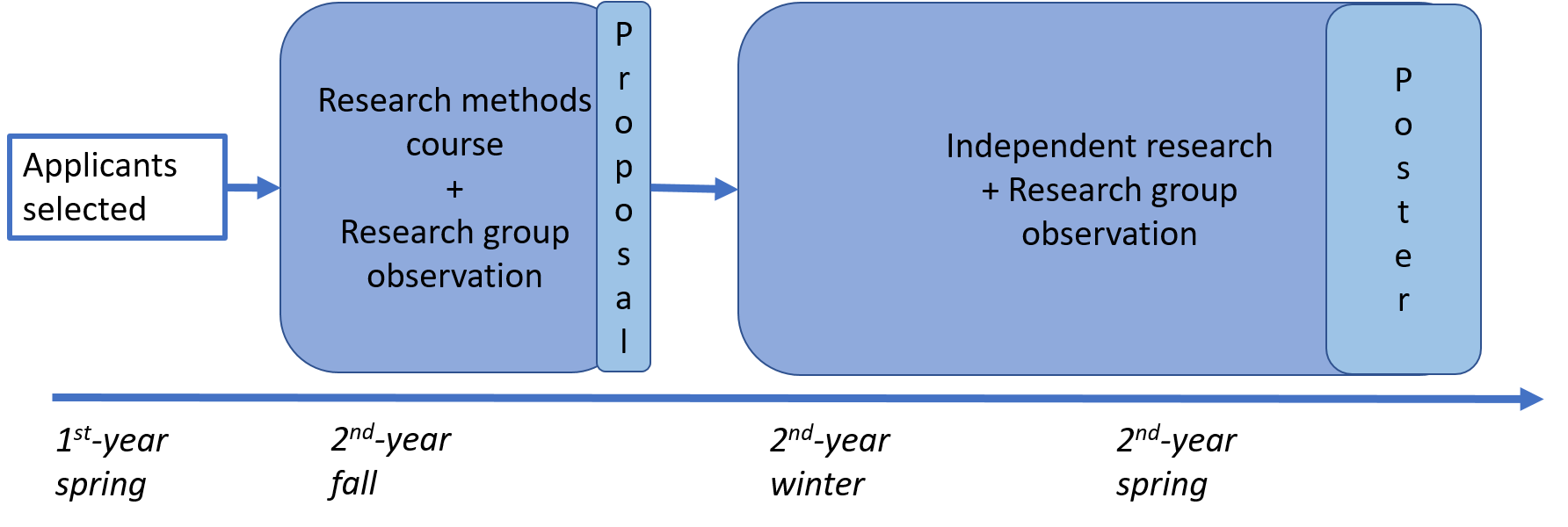
The team-based, dual mentoring structure is key to ERSP’s framework. During the research phase, which occurs in the winter and spring, students meet weekly with each of their research mentors, the ERSP graduate student assistant, and the ERSP director. The ERSP graduate student and director provide general research mentoring, helping students to work effectively as a team, plan tasks and meet self-imposed deadlines, communicate well with their team and their research mentor, and learn new skills on their own. This general mentoring frees up the research mentors to focus on more technical mentoring.
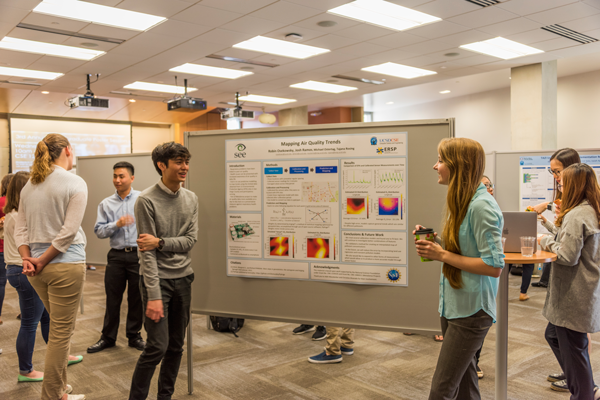
Reaching a Steady State
ERSP has been running for three years, and has reached a steady state of 40 participants in 10 projects per year. Over these three years, 99 undergraduates, including 72 women and one gender non-binary student, and 19 students from underrepresented racial and ethnic groups, have participated. ERSP retention is high: 70% of Cohort 1, 75% of Cohort 2, and 87% of Cohort 3 completed the full program.
We are working with CRA’s Center for Evaluating the Research Pipeline (CERP) to understand the impact ERSP has on its participants. An interview study conducted in spring 2017 indicates that the program is achieving its goals of exposure to research and building confidence and community for at least some participants [5]. For example, a student from Cohort 2 reports:
I can probably see myself in a grad program – Master’s and possibly Ph.D. later if that changes – easier now after this experience because before I was like “I’m not THAT smart. These people are like geniuses. No one does academic research just because they’re average. All these people are insanely intelligent.” But doing the research, I feel like I could do that. [5]
UC San Diego has a high number of first-generation college students, so it is not surprising that by default most students don’t even consider graduate school. ERSP helps some of these students see graduate school a path they could pursue. Along the same lines, ERSP also helps students build their professional networks, as this statement from a Cohort 1 student illustrates:
… the program is only a year long; I became friends with and got to know the graduate students that are supervised by the professors I got paired with. I kept working with the professors up until the third year. [5]
Finally, ERSP helps students develop teamwork skills. Multiple students discussed the challenges of working successfully in a team, as this quote from a Cohort 1 student illustrates:
I was like “OK, I can work with this type of person, I don’t want to work with this kind of worker.” Things like that. You just learn a lot about group dynamics. [5]
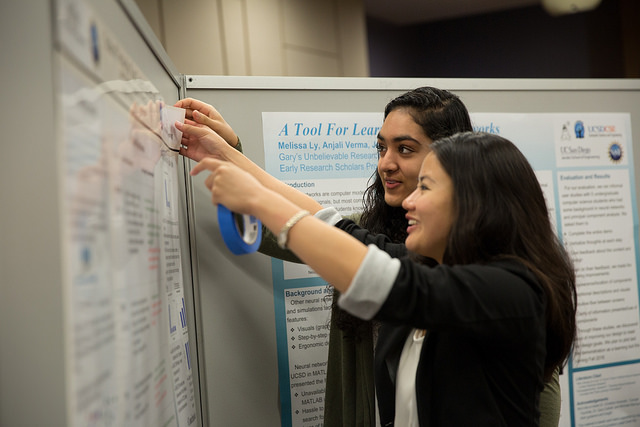 In fact, team work and group dynamics are one of the most challenging parts of ERSP. Undergraduates at UC San Diego (as at many universities) are busy, and prioritize “getting it done” over practicing communication and teamwork skills, which they often view as slowing down the process. Yet to be successful in their careers and in their lives, students must learn to productively work together, respecting their team members, and overcoming friction, even in the face of personality clashes. ERSP’s mandatory group-based framework, together with the dual-mentoring structure, helps them appreciate the reality and inevitability of these challenges and provides them with skills to overcome these issues.
In fact, team work and group dynamics are one of the most challenging parts of ERSP. Undergraduates at UC San Diego (as at many universities) are busy, and prioritize “getting it done” over practicing communication and teamwork skills, which they often view as slowing down the process. Yet to be successful in their careers and in their lives, students must learn to productively work together, respecting their team members, and overcoming friction, even in the face of personality clashes. ERSP’s mandatory group-based framework, together with the dual-mentoring structure, helps them appreciate the reality and inevitability of these challenges and provides them with skills to overcome these issues.
Promising Results
Results from quantitative survey data are subtler, and indicate that the quality of the group collaboration affects participants’ feelings of support and interest in pursuing further research opportunities. Students whose group collaborated well showed a stronger sense of growth mindset, felt more supported by the department and their peers, and showed more interest in pursuing research in industry or government [6]. Although we do not know the causal relationship in this result, it further supports the need to work with ERSP groups to ensure successful team dynamics.
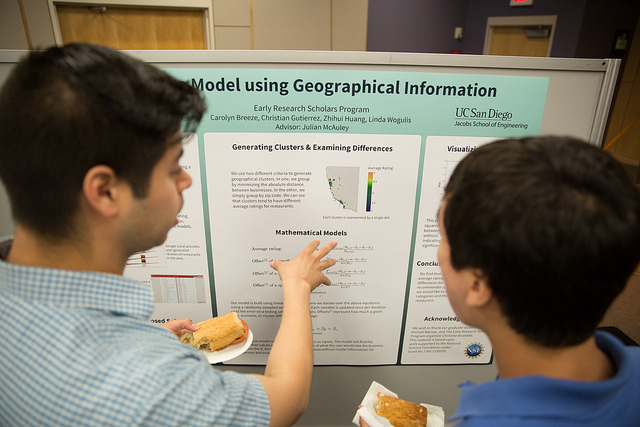
Our evaluation has also revealed other guidelines about how to best structure the program. In terms of project design, the best ERSP projects are those that are calibrated to students’ skill sets and allow students to see even superficial progress quickly and then to dive deeper as they acquire more technical knowledge and skills. For example, in one project, students collected air sensor measurements from several locations in the San Diego area, and then built models to predict air quality in other locations based on those measurements. The data collection phase allowed them to make concrete progress on their research task while they acquired the knowledge needed to apply the mathematical models.
Finally, logistical issues are one of the most challenging aspects of the program. Students and faculty have busy schedules, and the difficulties of finding meeting and work times can delay projects for weeks. We employ a few techniques to minimize scheduling difficulties. First, we use students’ schedules as a primary factor in setting group assignments at the start of the quarter. Although we also try to consider students’ interests, ensuring that they can attend their advisor’s research group meeting, and that they will have enough time to meet as a group during the week is the primary goal. Second, at the start of each quarter, we ask students to submit a weekly schedule with at least 2 hours outside of meeting times that the group will meet as a team. This practice has proven essential, as we have found that without this requirement, group members tend to work in isolation, occasionally communicating via an asynchronous channel, and do not collaborate nearly as successfully.
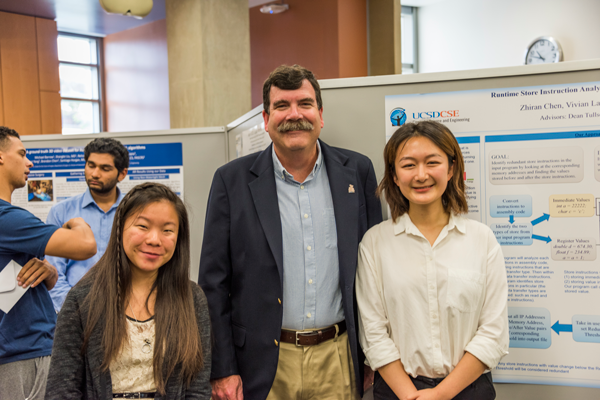
A Transformative Experience
Overall, we have found ERSP to be transformative for our department and its students. It has helped build a culture and practice of early undergraduate research, particularly for students from groups that are underrepresented in computer science. If you are interested in adopting ERSP at your institution, please see our ITiCSE 2016 paper [1] and our website (ersp.ucsd.edu), or contact Christine Alvarado (cjalvarado@eng.ucsd.edu) for more information.
References
[1] Barrow, M., Thomas, S., and Alvarado, C. J. (2016). ERSP: A Structured CS Research Program for Early-College Students. In Proceedings of the 2016 ACM Conference on Innovation and Technology in Computer Science Education (ITiCSE ’16). ACM, New York, NY, USA, 148-153.
[2] Margolis, J. and Fisher, A. (2002). Unlocking the Clubhouse: Women in Computing. Cambridge, MA: MIT Press.
[3] J. Margolis. (2008). Stuck in the Shallow End: Education, Race, and Computing. The MIT Press.
[4] Russell, S. H., Hancock, M. P. and McCullough, J. (2007). The pipeline: Benefits of undergraduate research experiences. Science, 316(5824):548{549, 2007.
[5] Stout, J. G. (2017). UCSD ERSP 2017 interview Report. Computing Research Association, Washington, D.C.
[6] Stout, J. G. (2017). University of California, San Diego Computer Science and Engineering Early Scholars Research Program: How Program Characteristics Shape the ERSP Experience.
Acknowledgements
This material is based upon work supported by the National Science Foundation under Grant No. CNS-1339335.
About the Author
Christine Alvarado is an associate teaching professor and vice chair for undergraduate affairs in the Computer Science and Engineering Department at the University of California, San Diego. She received her undergraduate degree in computer science from Dartmouth in 1998, and Master’s and Ph.D. degrees in computer science from MIT in 2000 and 2004, respectively. Her current efforts are focused on designing curriculum and programs to make computing and computing education more accessible and appealing, with the specific goal of increasing the number of women and underrepresented minorities who study computing. She is a co-chair of the AP Computer Science Principles development committee and a member of the CRA-Education committee. She has previously served on the College Board’s commission to design the new Advanced Placement Computer Science Principles, as a co-chair of the NCWIT Academic Alliance, and as general co-chair for the 2015 Grace Hopper Celebration of Women in Computing.


